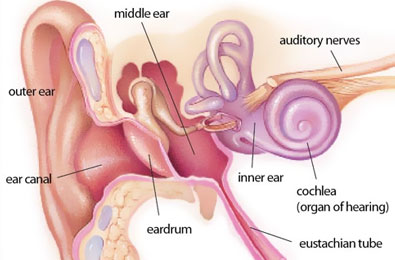Ears & Hearing
How do our ears work?

Our ears are the organs of hearing and balance. They have three sections: the outer ear, the middle ear and the inner ear.
The Outer Ear
The outer ear consists of the pinna and the ear canal. The pinna, which is the part that can be seen on the side of our head, directs sound into the ear canal. This is the passage that sound travels along to reach the eardrum. The passage is about 2.5cm long and lined with skin. If someone's ear is looked at from the side, the entrance to it can be seen.
Near the canal entrance there are hairs, and glands that produce wax. Together, these keep our ear canal clean. The eardrum (the tympanic membrane) covers the other end of the canal. When sound reaches the eardrum from the outside, it vibrates. Beyond the eardrum is the middle ear.
The Middle Ear
The middle ear is a space about 1.3 cm across, filled with air. This space is connected with the back of our throat by the eustachian tube. Most of the time the tube is closed, but if a person yawns, swallows or blows their nose, it opens. A clicking sound in our ears can be heard when this happens, which is normal.
A chain of three tiny bones stretches right across the middle ear space to pass sound from the eardrum to the oval window. The oval window is one of two membrane-covered openings of the inner ear. The three middle ear bones (the ossicles) are called the malleus, the incus and the stapes. They are also referred to as the hammer, anvil and stirrup.
The middle ear bones fit together like this:
- The malleus is attached to the inner side of the eardrum.
- The incus stretches between the malleus and the stapes.
- The base of the stapes fits into the oval window of the inner ear.
The middle ear bones work together like this:
- Sound enters our ears and makes the eardrum vibrate.
- Vibrations pass from the eardrum along the ossicles.
- The stapes pushes like a piston against the membrane in the oval window of the inner ear.
The Inner Ear
The inner ear has two parts:
- The cochlea is used for hearing.
- The vestibular part is used for balance.
Both are encased in bone.
The Cochlea
The cochlea (the hearing part) is a spiral tube about 3.5cm long that is coiled like a snail shell. The spiral contains two fluid-filled chambers - an outer and an inner one. The stapes fits into the oval window and sound vibrations pass from the stapes through the oval window and into the fluid in the outer chamber.
The inner chamber of the cochlea contains the organ of Corti. This has about 17,000 small hair cells along the length of the cochlea. Each cell has tiny hair-like structures called stereocilia, which project into the cochlear fluid. Hair cells are connected to the auditory nerve (also called the nerve of hearing), which goes from the cochlea to our brain.